Environmental Science Essay: Exploring Issues Facing Humans Today
VerifiedAdded on 2022/08/21
|5
|1138
|14
Essay
AI Summary
This essay examines three critical issues facing humanity: overpopulation, nuclear war, and genetic modification. Overpopulation is presented as a threat due to resource depletion and potential human rights violations. The essay highlights the devastating long-term effects of nuclear weapons, including environmental damage and potential human extinction. Finally, it explores the ethical concerns and future challenges associated with genetic modification, including the potential for human rights violations and the creation of social inequalities. The essay references several scholarly articles to support its claims and provides a comprehensive overview of these complex and pressing global issues.
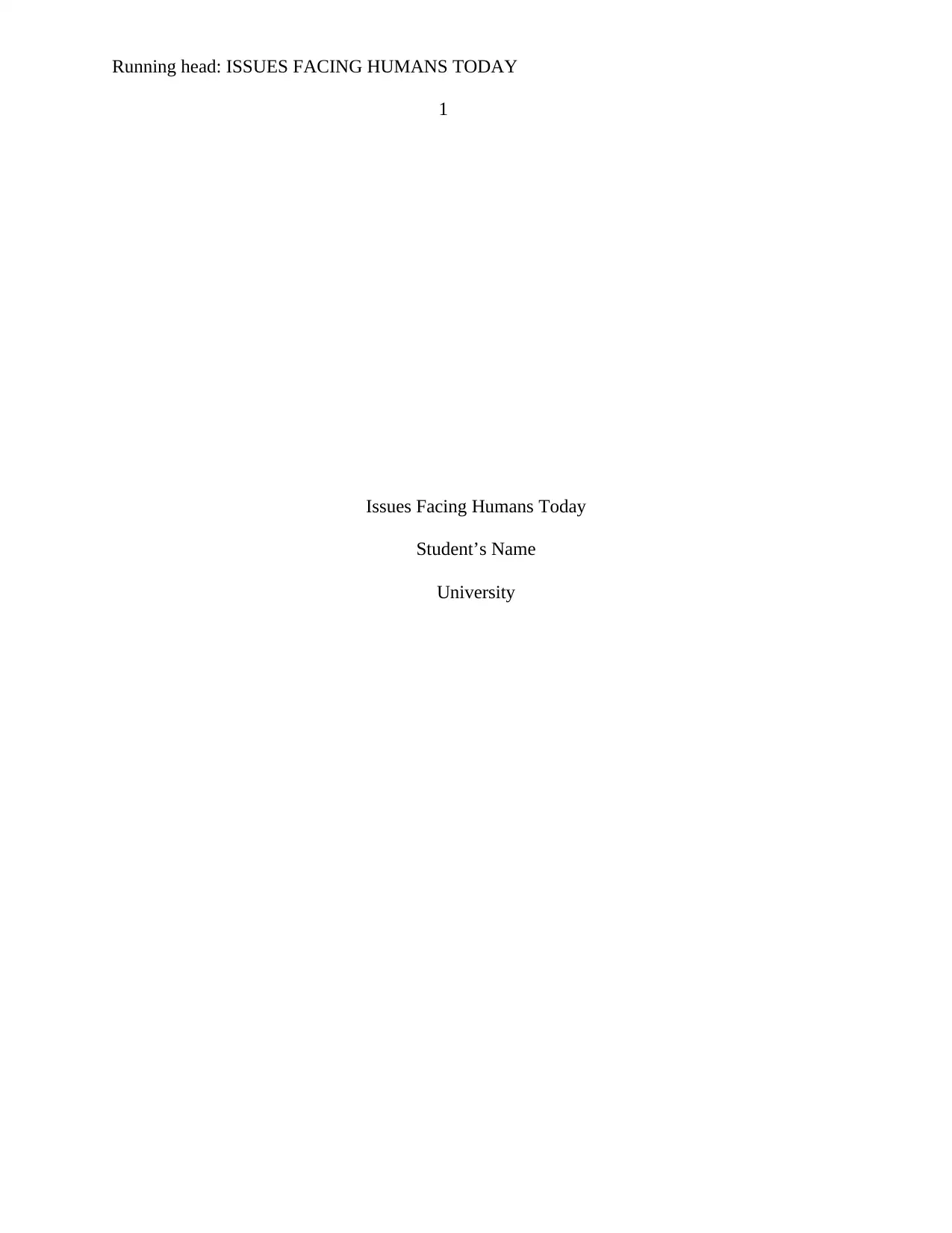
Running head: ISSUES FACING HUMANS TODAY
1
Issues Facing Humans Today
Student’s Name
University
1
Issues Facing Humans Today
Student’s Name
University
Paraphrase This Document
Need a fresh take? Get an instant paraphrase of this document with our AI Paraphraser
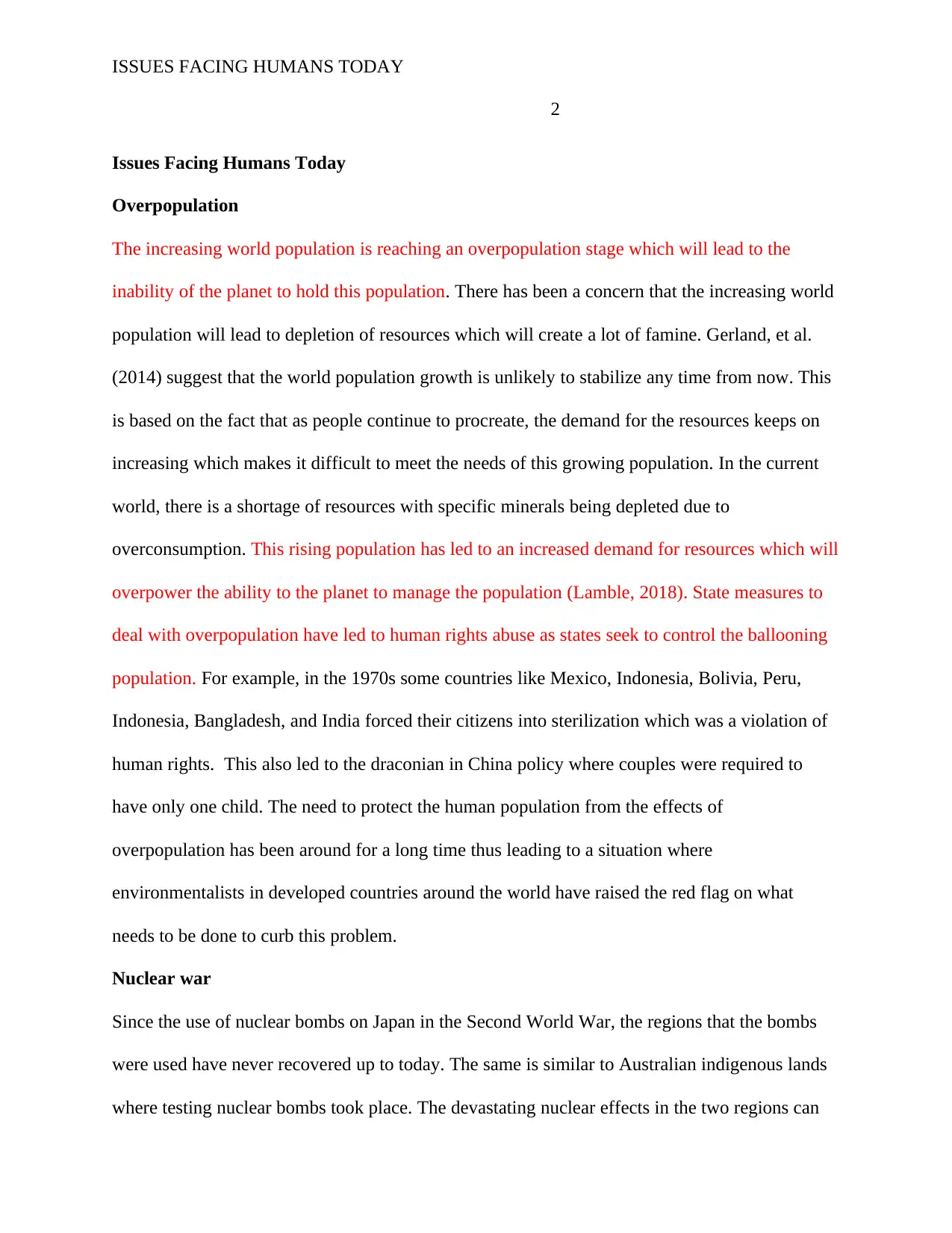
ISSUES FACING HUMANS TODAY
2
Issues Facing Humans Today
Overpopulation
The increasing world population is reaching an overpopulation stage which will lead to the
inability of the planet to hold this population. There has been a concern that the increasing world
population will lead to depletion of resources which will create a lot of famine. Gerland, et al.
(2014) suggest that the world population growth is unlikely to stabilize any time from now. This
is based on the fact that as people continue to procreate, the demand for the resources keeps on
increasing which makes it difficult to meet the needs of this growing population. In the current
world, there is a shortage of resources with specific minerals being depleted due to
overconsumption. This rising population has led to an increased demand for resources which will
overpower the ability to the planet to manage the population (Lamble, 2018). State measures to
deal with overpopulation have led to human rights abuse as states seek to control the ballooning
population. For example, in the 1970s some countries like Mexico, Indonesia, Bolivia, Peru,
Indonesia, Bangladesh, and India forced their citizens into sterilization which was a violation of
human rights. This also led to the draconian in China policy where couples were required to
have only one child. The need to protect the human population from the effects of
overpopulation has been around for a long time thus leading to a situation where
environmentalists in developed countries around the world have raised the red flag on what
needs to be done to curb this problem.
Nuclear war
Since the use of nuclear bombs on Japan in the Second World War, the regions that the bombs
were used have never recovered up to today. The same is similar to Australian indigenous lands
where testing nuclear bombs took place. The devastating nuclear effects in the two regions can
2
Issues Facing Humans Today
Overpopulation
The increasing world population is reaching an overpopulation stage which will lead to the
inability of the planet to hold this population. There has been a concern that the increasing world
population will lead to depletion of resources which will create a lot of famine. Gerland, et al.
(2014) suggest that the world population growth is unlikely to stabilize any time from now. This
is based on the fact that as people continue to procreate, the demand for the resources keeps on
increasing which makes it difficult to meet the needs of this growing population. In the current
world, there is a shortage of resources with specific minerals being depleted due to
overconsumption. This rising population has led to an increased demand for resources which will
overpower the ability to the planet to manage the population (Lamble, 2018). State measures to
deal with overpopulation have led to human rights abuse as states seek to control the ballooning
population. For example, in the 1970s some countries like Mexico, Indonesia, Bolivia, Peru,
Indonesia, Bangladesh, and India forced their citizens into sterilization which was a violation of
human rights. This also led to the draconian in China policy where couples were required to
have only one child. The need to protect the human population from the effects of
overpopulation has been around for a long time thus leading to a situation where
environmentalists in developed countries around the world have raised the red flag on what
needs to be done to curb this problem.
Nuclear war
Since the use of nuclear bombs on Japan in the Second World War, the regions that the bombs
were used have never recovered up to today. The same is similar to Australian indigenous lands
where testing nuclear bombs took place. The devastating nuclear effects in the two regions can
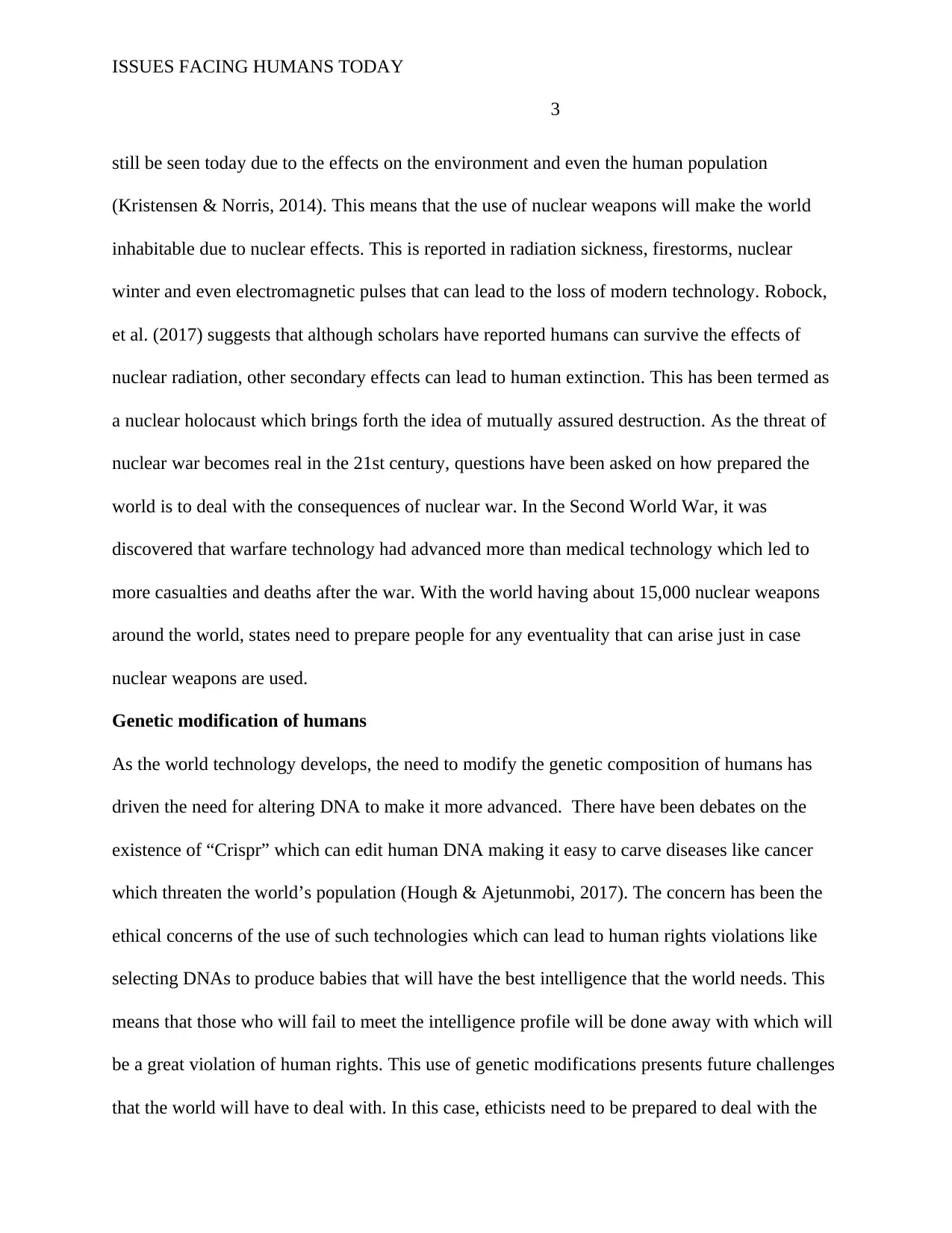
ISSUES FACING HUMANS TODAY
3
still be seen today due to the effects on the environment and even the human population
(Kristensen & Norris, 2014). This means that the use of nuclear weapons will make the world
inhabitable due to nuclear effects. This is reported in radiation sickness, firestorms, nuclear
winter and even electromagnetic pulses that can lead to the loss of modern technology. Robock,
et al. (2017) suggests that although scholars have reported humans can survive the effects of
nuclear radiation, other secondary effects can lead to human extinction. This has been termed as
a nuclear holocaust which brings forth the idea of mutually assured destruction. As the threat of
nuclear war becomes real in the 21st century, questions have been asked on how prepared the
world is to deal with the consequences of nuclear war. In the Second World War, it was
discovered that warfare technology had advanced more than medical technology which led to
more casualties and deaths after the war. With the world having about 15,000 nuclear weapons
around the world, states need to prepare people for any eventuality that can arise just in case
nuclear weapons are used.
Genetic modification of humans
As the world technology develops, the need to modify the genetic composition of humans has
driven the need for altering DNA to make it more advanced. There have been debates on the
existence of “Crispr” which can edit human DNA making it easy to carve diseases like cancer
which threaten the world’s population (Hough & Ajetunmobi, 2017). The concern has been the
ethical concerns of the use of such technologies which can lead to human rights violations like
selecting DNAs to produce babies that will have the best intelligence that the world needs. This
means that those who will fail to meet the intelligence profile will be done away with which will
be a great violation of human rights. This use of genetic modifications presents future challenges
that the world will have to deal with. In this case, ethicists need to be prepared to deal with the
3
still be seen today due to the effects on the environment and even the human population
(Kristensen & Norris, 2014). This means that the use of nuclear weapons will make the world
inhabitable due to nuclear effects. This is reported in radiation sickness, firestorms, nuclear
winter and even electromagnetic pulses that can lead to the loss of modern technology. Robock,
et al. (2017) suggests that although scholars have reported humans can survive the effects of
nuclear radiation, other secondary effects can lead to human extinction. This has been termed as
a nuclear holocaust which brings forth the idea of mutually assured destruction. As the threat of
nuclear war becomes real in the 21st century, questions have been asked on how prepared the
world is to deal with the consequences of nuclear war. In the Second World War, it was
discovered that warfare technology had advanced more than medical technology which led to
more casualties and deaths after the war. With the world having about 15,000 nuclear weapons
around the world, states need to prepare people for any eventuality that can arise just in case
nuclear weapons are used.
Genetic modification of humans
As the world technology develops, the need to modify the genetic composition of humans has
driven the need for altering DNA to make it more advanced. There have been debates on the
existence of “Crispr” which can edit human DNA making it easy to carve diseases like cancer
which threaten the world’s population (Hough & Ajetunmobi, 2017). The concern has been the
ethical concerns of the use of such technologies which can lead to human rights violations like
selecting DNAs to produce babies that will have the best intelligence that the world needs. This
means that those who will fail to meet the intelligence profile will be done away with which will
be a great violation of human rights. This use of genetic modifications presents future challenges
that the world will have to deal with. In this case, ethicists need to be prepared to deal with the
⊘ This is a preview!⊘
Do you want full access?
Subscribe today to unlock all pages.

Trusted by 1+ million students worldwide
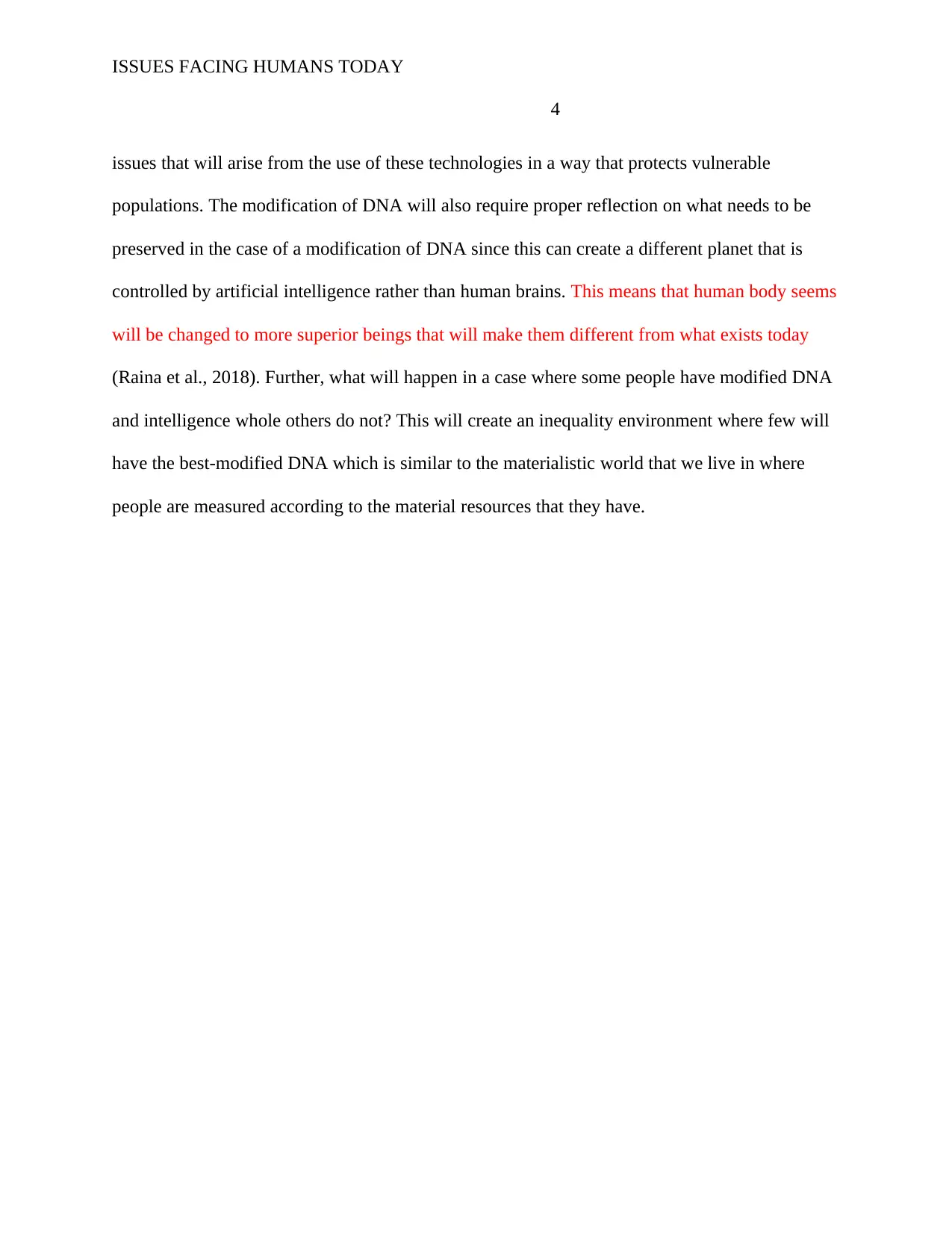
ISSUES FACING HUMANS TODAY
4
issues that will arise from the use of these technologies in a way that protects vulnerable
populations. The modification of DNA will also require proper reflection on what needs to be
preserved in the case of a modification of DNA since this can create a different planet that is
controlled by artificial intelligence rather than human brains. This means that human body seems
will be changed to more superior beings that will make them different from what exists today
(Raina et al., 2018). Further, what will happen in a case where some people have modified DNA
and intelligence whole others do not? This will create an inequality environment where few will
have the best-modified DNA which is similar to the materialistic world that we live in where
people are measured according to the material resources that they have.
4
issues that will arise from the use of these technologies in a way that protects vulnerable
populations. The modification of DNA will also require proper reflection on what needs to be
preserved in the case of a modification of DNA since this can create a different planet that is
controlled by artificial intelligence rather than human brains. This means that human body seems
will be changed to more superior beings that will make them different from what exists today
(Raina et al., 2018). Further, what will happen in a case where some people have modified DNA
and intelligence whole others do not? This will create an inequality environment where few will
have the best-modified DNA which is similar to the materialistic world that we live in where
people are measured according to the material resources that they have.
Paraphrase This Document
Need a fresh take? Get an instant paraphrase of this document with our AI Paraphraser
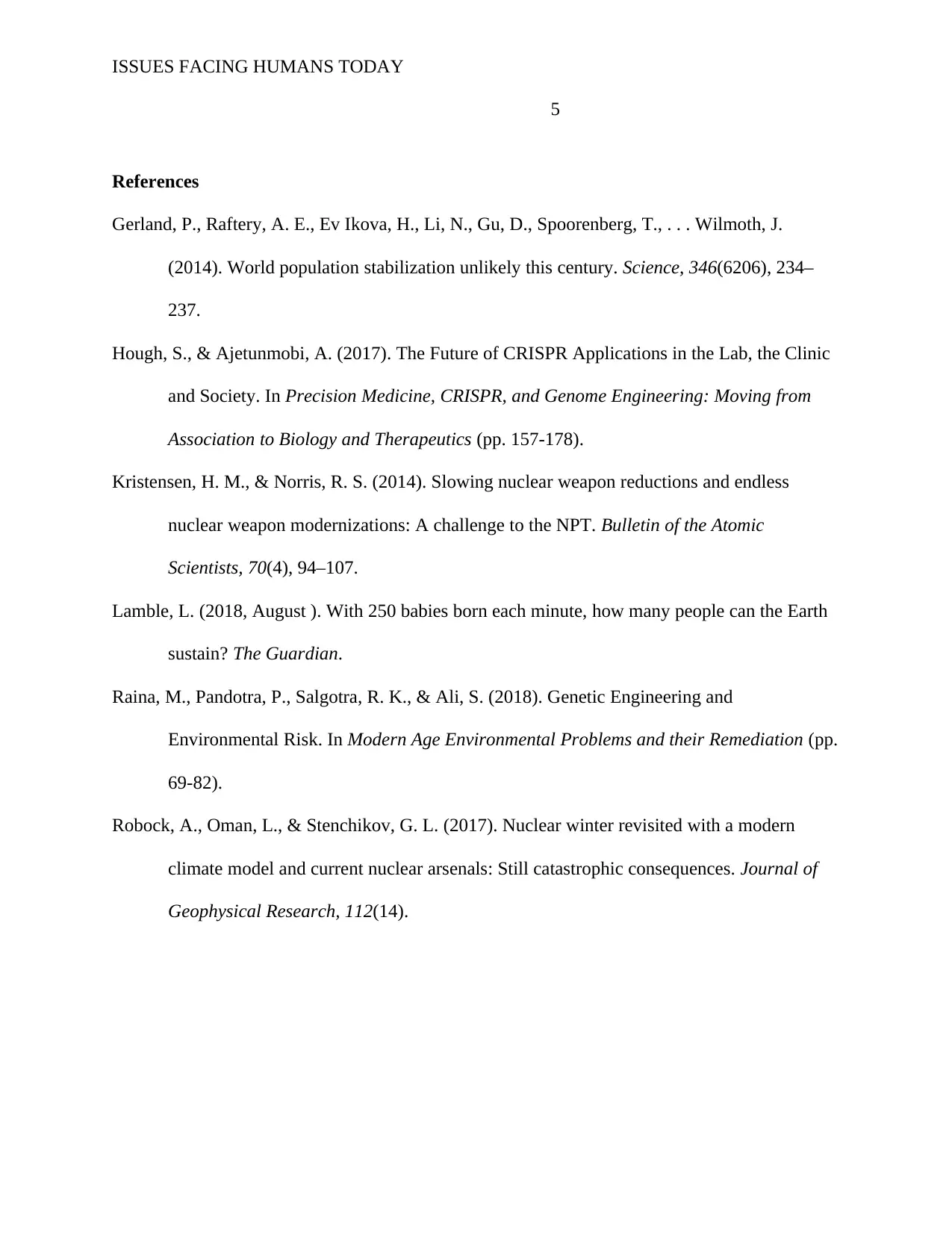
ISSUES FACING HUMANS TODAY
5
References
Gerland, P., Raftery, A. E., Ev Ikova, H., Li, N., Gu, D., Spoorenberg, T., . . . Wilmoth, J.
(2014). World population stabilization unlikely this century. Science, 346(6206), 234–
237.
Hough, S., & Ajetunmobi, A. (2017). The Future of CRISPR Applications in the Lab, the Clinic
and Society. In Precision Medicine, CRISPR, and Genome Engineering: Moving from
Association to Biology and Therapeutics (pp. 157-178).
Kristensen, H. M., & Norris, R. S. (2014). Slowing nuclear weapon reductions and endless
nuclear weapon modernizations: A challenge to the NPT. Bulletin of the Atomic
Scientists, 70(4), 94–107.
Lamble, L. (2018, August ). With 250 babies born each minute, how many people can the Earth
sustain? The Guardian.
Raina, M., Pandotra, P., Salgotra, R. K., & Ali, S. (2018). Genetic Engineering and
Environmental Risk. In Modern Age Environmental Problems and their Remediation (pp.
69-82).
Robock, A., Oman, L., & Stenchikov, G. L. (2017). Nuclear winter revisited with a modern
climate model and current nuclear arsenals: Still catastrophic consequences. Journal of
Geophysical Research, 112(14).
5
References
Gerland, P., Raftery, A. E., Ev Ikova, H., Li, N., Gu, D., Spoorenberg, T., . . . Wilmoth, J.
(2014). World population stabilization unlikely this century. Science, 346(6206), 234–
237.
Hough, S., & Ajetunmobi, A. (2017). The Future of CRISPR Applications in the Lab, the Clinic
and Society. In Precision Medicine, CRISPR, and Genome Engineering: Moving from
Association to Biology and Therapeutics (pp. 157-178).
Kristensen, H. M., & Norris, R. S. (2014). Slowing nuclear weapon reductions and endless
nuclear weapon modernizations: A challenge to the NPT. Bulletin of the Atomic
Scientists, 70(4), 94–107.
Lamble, L. (2018, August ). With 250 babies born each minute, how many people can the Earth
sustain? The Guardian.
Raina, M., Pandotra, P., Salgotra, R. K., & Ali, S. (2018). Genetic Engineering and
Environmental Risk. In Modern Age Environmental Problems and their Remediation (pp.
69-82).
Robock, A., Oman, L., & Stenchikov, G. L. (2017). Nuclear winter revisited with a modern
climate model and current nuclear arsenals: Still catastrophic consequences. Journal of
Geophysical Research, 112(14).
1 out of 5
Related Documents
Your All-in-One AI-Powered Toolkit for Academic Success.
+13062052269
info@desklib.com
Available 24*7 on WhatsApp / Email
![[object Object]](/_next/static/media/star-bottom.7253800d.svg)
Unlock your academic potential
Copyright © 2020–2025 A2Z Services. All Rights Reserved. Developed and managed by ZUCOL.





